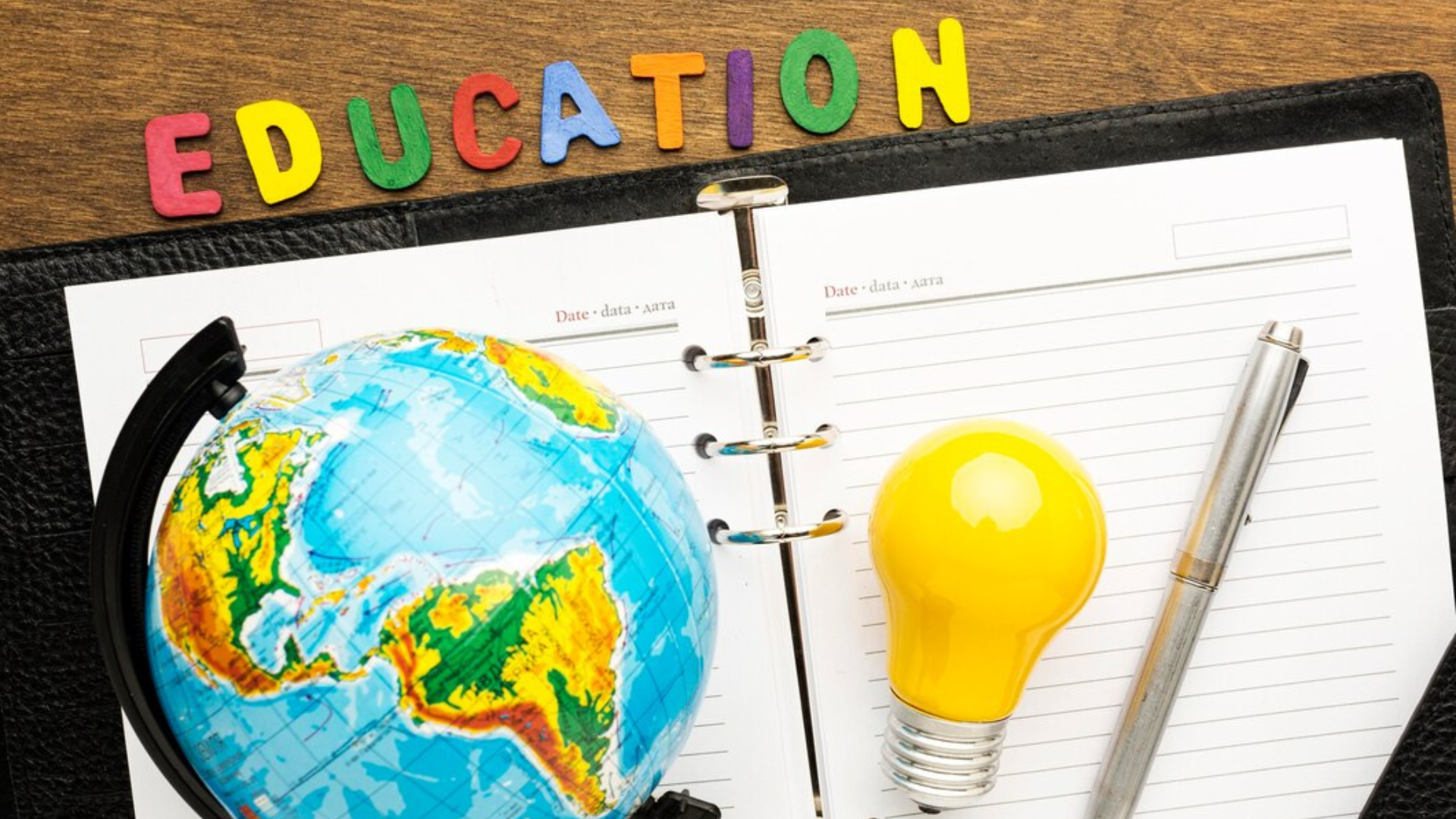EDUCATION
Top 10 Countries with the Best Educational Systems: A Global Comparison

Education is often heralded as the cornerstone of progress. It shapes individuals, influences societies, and drives economies toward growth. As we navigate an increasingly interconnected world, the importance of a strong educational system cannot be overstated. But which countries lead the charge in creating environments where students thrive?
When it comes to identifying the best educational systems globally, various factors come into play—from teaching methods and curriculum standards to student well-being and parental involvement. In this blog post, we’ll take a closer look at the top 10 countries with exemplary educational systems that not only prioritize academic excellence but also foster holistic development for their learners.
Get ready to explore how these nations have set benchmarks for education worldwide!
Criteria Used for Ranking Educational Systems
When assessing the best educational system in the world, several criteria come into play. Quality of education is paramount. This includes curriculum rigor, teaching methodologies, and student engagement.
Another important factor is accessibility. A great educational system ensures that all students have equal access to learning resources regardless of their background or location.
Student performance on standardized tests offers insight into how well a system prepares its learners for future challenges. Additionally, graduation rates serve as a barometer for overall effectiveness.
Teacher qualifications also matter significantly. Highly skilled educators contribute to better learning outcomes and foster a positive environment for growth.
Investment in education plays a crucial role. Countries that allocate sufficient funding tend to provide more comprehensive support services and infrastructure improvements. Each of these elements intertwines to create an effective educational landscape worthy of ranking among the best globally.
Top 10 Countries with the Best Educational Systems:
When it comes to the best educational system in the world, Finland often tops the list. Its emphasis on creativity and critical thinking fosters independent learners.
South Korea is another standout, known for its rigorous academic standards and high student performance. The culture values education deeply, motivating students to excel.
Japan combines tradition with innovation. Its structured approach ensures discipline while embracing modern teaching methods.
Singapore’s education model emphasizes a strong foundation in STEM subjects. This focus prepares students for global competitiveness.
Hong Kong excels by integrating diverse perspectives into its curriculum, promoting bilingualism and cultural understanding.
Canada showcases inclusivity in education. It values multiculturalism while maintaining high standards across provinces.
Estonia has transformed its educational landscape through digital learning initiatives that engage students effectively.
Switzerland offers vocational training alongside traditional academics, ensuring practical skills development.
The United Kingdom boasts prestigious universities that attract international talent through quality instruction and research opportunities.
The Netherlands encourages student autonomy within a robust framework of support systems.
A. Finland
Finland consistently ranks as a leader in global education. Its approach focuses on equity and inclusiveness, ensuring that every child receives quality education regardless of their background.
One standout feature is the minimal emphasis on standardized testing. Instead, teachers assess students through continuous observation and personal engagement. This fosters a supportive learning environment where creativity flourishes.
Teachers in Finland are highly respected professionals, often holding master’s degrees. They enjoy significant autonomy in designing curricula tailored to their students’ needs.
Class sizes are small, allowing for personalized attention. Students also benefit from shorter school days and less homework compared to other countries, promoting a healthy work-life balance.
Outdoor learning is integral to Finnish education, with nature incorporated into lessons. This holistic approach cultivates not just academic skills but also social and emotional growth among students.
B. South Korea
South Korea’s educational system is renowned for its rigor and high academic standards. The country consistently ranks among the top in global assessments, showcasing impressive results in subjects like mathematics, science, and reading.
A strong emphasis on discipline and hard work shapes the educational culture. Students often attend school from early morning until late evening, supplemented by additional tutoring known as “hagwons.” This commitment to education fosters a competitive spirit that drives achievement.
Innovative teaching methods also play a crucial role. South Korean educators focus on interactive learning, integrating technology into classrooms to enhance engagement.
Moreover, the government invests heavily in education infrastructure and resources. These strategies create an environment where students can thrive academically while preparing them for future challenges in a rapidly changing world.
C. Japan
Japan’s educational system is renowned for its rigor and effectiveness. It emphasizes discipline, respect, and a strong work ethic from an early age. Children typically start formal education at the age of six, where they are introduced to a well-structured curriculum that combines academics with moral education.
One standout feature is the focus on group learning. Students often engage in collaborative activities that foster teamwork and communication skills. This method not only enhances their social abilities but also prepares them for future professional environments.
The school year is divided into trimesters, allowing for breaks to recharge mentally and physically. Moreover, Japanese schools prioritize physical wellness through sports and cultural programs—an essential aspect of holistic development.
Teachers play a crucial role in this framework, earning great respect within society. They are dedicated professionals who continuously seek ways to improve their teaching methods for better student engagement and success rates.
D. Singapore
Singapore stands out as a beacon of educational excellence. Its rigorous curriculum emphasizes critical thinking and problem-solving, preparing students for the complexities of modern life.
The nation invests heavily in teacher training. Educators undergo continuous professional development, ensuring they stay updated on the latest pedagogical strategies. This commitment to quality instruction fosters an environment where learning thrives.
Standardized testing is prevalent, but it’s balanced with creative subjects like arts and music. This holistic approach nurtures well-rounded individuals who excel academically while being culturally aware.
Furthermore, Singapore’s emphasis on technology is evident in classrooms equipped with digital tools that enhance learning experiences. Students engage in collaborative projects that promote teamwork and innovation.
With a strong focus on STEM subjects, Singapore consistently ranks high in international assessments like PISA. The dedication to producing skilled graduates positions this city-state as a leader in global education standards.
E. Hong Kong
Hong Kong boasts a highly regarded educational system, blending Eastern and Western philosophies. Its approach focuses on academic excellence while nurturing critical thinking skills.
Students in Hong Kong consistently perform well in international assessments. The curriculum emphasizes not only core subjects like math and science but also the arts and humanities. This diverse offering prepares students for a globalized world.
Schools here often have high expectations, fostering discipline and hard work among pupils. Teachers are well-trained, with many holding advanced degrees themselves. Their commitment to education is evident in their dedication to student success.
Extracurricular activities play an essential role too, promoting holistic development outside traditional academics. From sports teams to cultural clubs, students find opportunities to explore their interests further.
This combination of rigorous academics and supportive environments makes Hong Kong stand out as a leader in educational achievement worldwide.
F. Canada
Canada boasts an impressive educational system, recognized for its inclusivity and high standards. The country emphasizes equal access to education for all students, regardless of their background.
Canadian provinces have the authority to shape their own curriculums. This decentralized approach allows regions to tailor education to meet local needs effectively. Students benefit from a diverse range of programs that promote creativity and critical thinking.
Teachers in Canada are well-trained and respected professionals. With strong support systems in place, they focus on fostering student engagement and well-being.
Moreover, Canada’s commitment to lifelong learning encourages citizens to pursue education beyond traditional schooling. This focus not only enhances individual opportunities but also strengthens the nation’s workforce as a whole.
In recent years, Canada has also prioritized mental health resources within schools, recognizing the importance of emotional well-being alongside academic success.
G. Estonia
Estonia has emerged as a beacon of educational excellence in recent years. Its innovative approach to learning has caught global attention, making it one of the top contenders for the best educational system in the world.
A significant factor contributing to Estonia’s success is its focus on technology integration. Classrooms are equipped with advanced digital tools that enhance both teaching and learning experiences. This enables students to engage actively with their studies.
Moreover, Estonia prioritizes teacher training. Educators receive substantial support and continuous professional development, ensuring they remain at the forefront of pedagogical practices.
The curriculum emphasizes critical thinking and problem-solving skills rather than rote memorization. Students are encouraged to explore ideas creatively and collaboratively.
With a strong commitment to inclusivity, Estonia ensures all children have access to quality education regardless of their background or needs, setting an inspiring example for other nations looking to improve their systems.
H. Switzerland
Switzerland stands out for its exceptional educational framework. The country emphasizes a blend of theory and practical skills, which equips students with real-world knowledge.
Each region, or canton, manages its own education system. This decentralized approach allows for tailored curriculums that meet local needs while adhering to national standards.
Students in Switzerland benefit from multilingualism, learning at least three languages during their schooling. This linguistic diversity fosters cultural awareness and enhances communication skills.
The Swiss model also includes vocational training options alongside traditional academic paths. This dual system ensures that all students have access to pathways suited to their interests and strengths.
Furthermore, the collaboration between schools and industries is robust. Companies often partner with educational institutions to provide internships and apprenticeships, bridging the gap between academia and the workforce.
I. United Kingdom
The United Kingdom boasts a long-standing tradition of academic excellence. Institutions like Oxford and Cambridge are renowned worldwide, attracting students from all corners of the globe.
Education in the UK emphasizes critical thinking and creativity. The curriculum is designed to encourage inquiry rather than rote memorization. Students engage with subjects deeply, fostering a love for learning that extends far beyond the classroom.
Moreover, the UK places great importance on inclusivity. Programs aimed at helping disadvantaged groups ensure that quality education is accessible to all.
Teachers in the UK undergo rigorous training, equipping them with skills to adapt their methods for diverse learners. This focus on professional development contributes significantly to effective teaching practices across schools.
With its blend of historical prestige and contemporary innovation, the UK’s educational system remains one of the best educational systems in the world today.
J. Netherlands
The Netherlands boasts a progressive educational system renowned for its innovative approaches. With a focus on student-centered learning, the country emphasizes critical thinking and creativity rather than rote memorization.
Dutch schools encourage collaborative projects, allowing students to engage with each other actively. This method fosters communication skills and prepares them for real-world challenges.
Teachers in the Netherlands enjoy significant autonomy in their classrooms. They can tailor lessons to meet individual student needs, ensuring that everyone has an opportunity to succeed.
Additionally, higher education is accessible and internationally recognized. Many universities offer programs in English, attracting students from around the globe.
With a commitment to equity and inclusiveness, Dutch policies ensure that education remains available regardless of socio-economic background. This dedication contributes significantly to making it one of the best educational systems in the world.
Common Factors among Top Ranked Countries
Countries with the best educational systems share several key characteristics. A strong emphasis on teacher training stands out prominently. Top-ranked nations invest in continuous professional development, ensuring educators are equipped with the latest pedagogical strategies.
Equity and access also play a crucial role. These countries prioritize inclusive education, providing resources to underserved communities. This commitment helps bridge gaps and ensures every child receives quality instruction.
Curriculum flexibility is another commonality among these nations. They adapt their teaching methods to suit diverse learning styles, fostering creativity alongside critical thinking skills.
Parental involvement significantly enhances student performance as well. Engaged families contribute positively to academic success by supporting learning at home and collaborating with schools.
An overall respect for education permeates society in these top-performing countries. Education isn’t just seen as a necessity; it’s regarded as a valuable investment in future generations.
Challenges Facing Educational Systems and Solutions Implemented by Top Ranked Countries
Many educational systems face significant challenges, such as inequality in access to quality education. Disparities in resources can hinder the learning experience for students from disadvantaged backgrounds.
Top-ranked countries like Finland and Singapore have addressed this issue by investing heavily in teacher training. They emphasize continuous professional development to ensure educators are well-equipped and motivated.
Another common challenge is adapting to rapid technological changes. Countries leading in education have embraced digital tools, integrating them into their curricula. This approach prepares students for a tech-driven world while keeping engagement levels high.
Mental health concerns among students also pose obstacles. Nations like Canada prioritize mental wellness programs within schools, fostering environments where emotional support is readily available.
These solutions highlight innovative approaches that not only address specific issues but also pave the way for sustainable improvements across various educational landscapes.
The Impact of a
The impact of a robust educational system transcends borders. It shapes economies, influences social structures, and fosters innovation. Countries with effective education frameworks tend to enjoy higher economic growth rates.
Students equipped with critical thinking skills are more likely to engage in problem-solving and creativity. This leads to advancements in various fields like technology and healthcare.
Furthermore, quality education promotes equality. Access for all students reduces disparities based on socio-economic status or geography. Nations that prioritize inclusivity empower their citizens.
Long-term benefits arise from educated populations as well. Health outcomes improve when individuals understand the importance of nutrition and wellness practices.
An exceptional educational system lays the groundwork for a sustainable future by creating informed global citizens who are ready to tackle pressing challenges together.
Factors Considered in Ranking Educational Systems
When assessing educational systems, several crucial factors come into play. Academic performance is often measured through standardized testing scores and international assessments like PISA.
Teacher quality also holds significant weight. Countries with well-trained educators tend to foster better learning environments. Investment in professional development for teachers can lead to improved outcomes for students.
Curriculum relevance cannot be overlooked either. A curriculum that adapts to the changing needs of society prepares students effectively for future challenges.
Access to education plays a vital role as well. Systems that provide equitable opportunities ensure that all children, regardless of background, receive quality education.
Parental involvement and community engagement contribute positively to student success. When families are invested in their children’s education, it creates a supportive network conducive to learning and growth.
Top 10 Countries with the Best Educational Systems
Education shapes the future of individuals and nations. Some countries stand out for their exceptional educational systems, making them models to emulate.
Finland leads with its innovative approaches, emphasizing student well-being over standardized testing. South Korea follows closely, boasting rigorous academic standards that have consistently produced high-performing students.
Japan combines discipline with creativity in classrooms, creating a balanced learning environment. Singapore’s education system is renowned for its strong focus on STEM subjects and critical thinking skills.
Hong Kong boasts a unique blend of Eastern and Western educational philosophies. Meanwhile, Canada offers inclusive education policies that cater to diverse populations.
Estonia has gained recognition for integrating technology seamlessly into learning processes. Switzerland presents multilingual instruction as part of its curriculum, reflecting cultural diversity.
The UK maintains strong global rankings through prestigious institutions like Oxford and Cambridge. The Netherlands emphasizes student autonomy within a structured framework. Each country showcases distinct strategies contributing to their success in providing quality education.
Case Studies: How These Countries Achieved Success
Finland’s educational success stems from its focus on teacher autonomy. In this system, educators design their own curriculum and assessments. This empowerment fosters creativity and innovation in teaching methods.
South Korea emphasizes rigorous academic standards combined with a strong societal respect for teachers. After school programs and tutoring are common, ensuring students have ample support to excel.
Japan blends tradition with modernity. Its unique approach includes moral education alongside academics, cultivating well-rounded individuals who value teamwork and discipline.
Singapore’s meritocracy drives excellence. The nation invests heavily in training teachers while implementing data-driven strategies that track student progress precisely.
Canada stands out for inclusivity. By prioritizing equitable access to quality education across diverse populations, it creates a supportive environment where every child can thrive.
Estonia utilizes digital tools effectively. With technology integrated into classrooms, students engage in collaborative learning experiences that prepare them for the future job market.
Challenges and Criticisms
Despite their successes, top educational systems face unique challenges. Critics often highlight the pressure placed on students in countries like South Korea and Japan. This intense focus on exams can lead to high stress levels and mental health issues among young learners.
Another concern involves equity. While many systems excel overall, disparities persist within them. In Canada, for instance, indigenous students still experience achievement gaps compared to their non-indigenous peers.
Funding is also a hot topic. Countries with strong educational frameworks must constantly balance budgets while ensuring quality resources reach every school.
Moreover, adapting curricula to meet the needs of a rapidly changing world poses additional difficulties. The integration of technology into classrooms requires ongoing training for educators and substantial investment from governments.
These complexities remind us that even the best educational system in the world is not without its flaws or obstacles.
Implementing Changes in Other Countries
Countries looking to improve their educational systems can draw inspiration from those that excel. However, it’s essential to tailor strategies to local contexts. What works in Finland may not be directly applicable in India or Brazil.
For instance, fostering a culture of collaboration and trust between educators is vital. Countries like Japan emphasize teamwork among teachers, allowing them to share best practices and innovate together.
Investing in teacher training cannot be overlooked. Successful countries prioritize ongoing professional development, ensuring educators are equipped with the latest teaching methods and resources.
Additionally, incorporating technology thoughtfully can significantly enhance learning experiences. Countries should assess how digital tools can complement traditional teaching without overshadowing interpersonal interactions.
Engaging communities plays a crucial role in reform efforts. When parents and stakeholders become involved, they help create a supportive environment that values education as a shared responsibility.
Conclusion
Education is a cornerstone for societal development. The best educational systems in the world don’t just focus on rote memorization; they emphasize critical thinking, creativity, and emotional intelligence. Countries like Finland and South Korea have set benchmarks by blending traditional values with modern pedagogical approaches.
These top-ranking nations share common attributes such as highly qualified teachers, robust curricula, and an emphasis on equity. They also face challenges that require constant adaptation. Issues like curriculum relevance, technological integration, and socio-economic disparities highlight areas needing attention even among the best.
Studying these countries provides valuable insights for others aiming to improve their educational outcomes. By adopting tailored strategies from successful models while considering local contexts, nations can elevate their education systems significantly.
As we look towards the future of global education, it becomes clear that fostering innovation and inclusivity will be crucial in shaping capable individuals ready to tackle upcoming challenges. The journey toward establishing the best educational system in the world continues—a collaborative effort involving educators, policymakers, families, and communities alike will pave ways for transformative change across borders.
EDUCATION
Navigating the Costs: Tips for Managing Out of State Tuition on a Budget

Navigating the world of higher education can feel overwhelming, especially when faced with the daunting prospect of out-of-state tuition. For many students, attending a school outside their home state opens doors to new opportunities and experiences. However, the financial burden can be significant. Fortunately, there are ways to manage these costs effectively without sacrificing your educational goals.
Whether you’re dreaming of that prestigious university across the country or simply exploring options in neighboring states, understanding how to make affordable out-of-state tuition a reality is essential. Follow along as we explore practical strategies and tips that will help you keep your budget intact while pursuing your academic dreams!
Understanding Out of State Tuition
Out-of-state tuition can be a real eye-opener for many students. Unlike in-state rates, which are often subsidized by state taxes, out-of-state fees reflect the full cost of attending a public university. This difference can sometimes be staggering.
Each institution sets its own rates based on various factors like funding and enrollment numbers. As such, it’s crucial to research each school’s pricing structure thoroughly.
Additionally, some states have reciprocity agreements or regional programs that allow residents from specific neighboring states to pay reduced tuition rates. These agreements can make a significant difference if you’re considering schools close to home.
Understanding these nuances helps you navigate the financial landscape more effectively and informs better choices when selecting your college destination.
Factors that Affect Out of State Tuition Rates
Out of state tuition rates can vary significantly from one institution to another. Multiple factors influence these costs.
First, the university’s funding structure plays a crucial role. Public universities often rely on state funding, which means out-of-state students may face higher fees compared to in-state counterparts.
Location is another key element. Schools situated in urban areas typically have higher living expenses that contribute to overall tuition costs.
Additionally, program demand impacts pricing. Specialized programs or those with limited spots might charge more for out-of-state applicants due to their popularity and resource allocation.
Tuition policies also differ based on institutional priorities and strategic goals. Some universities are keen on attracting diverse student populations, while others focus primarily on local enrollment, influencing their pricing strategies accordingly.
Financial aid availability can also change the final amount owed by students who qualify for assistance or merit-based scholarships.
Strategies for Reducing Out of State Tuition Costs
One effective strategy is to research schools that offer tuition discounts for out-of-state students. Some universities provide reduced rates based on academic merit or special programs.
Another approach is to take advantage of online courses. Many institutions charge lower fees for remote learning, allowing you to save significantly while earning credits toward your degree.
Consider enrolling in a community college first. Completing general education requirements at a local institution can be cost-effective before transferring to a four-year university, often at an in-state rate.
Don’t overlook the power of negotiation. Reach out directly to the admissions office and inquire about any available financial aid options tailored specifically for out-of-state students. They might have insights into lesser-known scholarships or grants that could ease your financial burden.
Applying for Scholarships and Grants
Scholarships and grants are lifelines for students facing the burden of out-of-state tuition. They can significantly reduce your overall costs, making education more accessible.
Start by researching opportunities available specifically for out-of-state students. Many schools offer merit-based scholarships that reward academic excellence or unique talents. Don’t overlook local organizations; they often provide funding to residents heading to college.
Fill out the Free Application for Federal Student Aid (FAFSA). This essential step opens doors to federal grants and state aid programs, even if you’re studying outside your home state.
Tailor each application to highlight what makes you a strong candidate. Personalize essays with compelling stories about your journey and aspirations.
Remember, deadlines can sneak up on you! Stay organized and keep track of all requirements for each scholarship or grant application. Efforts spent here can lead to significant savings on affordable out-of-state tuition.
Considering In-State Residency Options
One of the most effective ways to manage out of state tuition is by exploring in-state residency options. Many states have specific criteria for students wishing to gain resident status, and understanding these requirements can save you a significant amount on tuition costs.
Start by checking your school’s guidelines. Each institution may define residency differently, often considering factors like employment history or parental residence.
You might also need to establish physical presence in the state. This could involve moving there prior to enrollment, obtaining a local driver’s license, or registering to vote.
Engaging with local communities can further strengthen your case for residency. Participate in events or volunteer activities that show your commitment to living in the state long-term.
Researching each state’s unique policies will equip you with valuable information that could make attending school more affordable than ever before.
Budgeting Tips for Out of State Students
Creating a budget is essential for out of state students. Start by listing all your potential expenses, including tuition, housing, food, and transportation. This will give you a comprehensive view of what to expect.
Consider using budgeting apps or spreadsheets to track your spending. Visualizing where your money goes can help identify areas where you might cut back.
Don’t forget about hidden costs like textbooks and supplies. Check if digital versions are more affordable or explore used options.
Eating out can quickly drain funds, so plan meals at home as much as possible. Cooking in batches saves time and money.
Look for student discounts on local services and activities. Every little bit helps when you’re striving for affordable out of state tuition!
Conclusion
Navigating the world of out-of-state tuition can feel overwhelming, especially when trying to manage costs on a budget. It’s important to understand what drives these expenses and how you can take control of your finances without sacrificing educational opportunities.
By exploring scholarships, grants, and creative ways to establish in-state residency, students can significantly reduce their financial burden. Additionally, budgeting wisely allows for better management of day-to-day expenses while studying away from home.
Remember that every little bit counts. Taking proactive steps today not only eases the stress but also paves the way for a brighter academic future. Embrace these strategies as you work towards achieving your educational dreams at an affordable price!
EDUCATION
The Best EdTech Companies Of 2025 (Watch List)

The landscape of education is rapidly evolving, and at the forefront of this transformation are EdTech companies. These innovators harness technology to enhance learning experiences, making education more accessible and effective than ever before. As we look ahead to 2025, it’s clear that these firms will play a crucial role in shaping the future of how we teach and learn.
With classrooms becoming increasingly digital, students now have access to tools that cater to diverse learning styles and needs. The importance of EdTech cannot be overstated; it bridges gaps, fosters engagement, and prepares learners for a tech-driven world. It’s an exciting time for educators and students alike as they embrace new methodologies designed not just for retention but true understanding.
As we delve into the best EdTech companies on our watch list for 2025, we’ll explore what sets them apart in this dynamic environment. Get ready to discover groundbreaking innovations that promise to revolutionize education as we know it!
Importance of EdTech in Education
EdTech plays a crucial role in reshaping education today. It enhances accessibility for students, allowing them to learn from anywhere at any time. This flexibility is vital in an increasingly mobile world.
Moreover, EdTech tools can cater to various learning styles. Whether visual, auditory, or kinesthetic learners, technology provides tailored experiences that traditional classrooms might overlook.
Engagement also skyrockets with innovative digital resources. Interactive lessons and multimedia content keep students interested and motivated throughout their educational journey.
Additionally, EdTech enables educators to track progress efficiently. Data analytics help identify strengths and weaknesses in student performance, leading to more effective teaching strategies.
Collaboration becomes seamless through online platforms as well. Students from diverse backgrounds can connect and share ideas worldwide, enriching the learning experience beyond local boundaries.
Criteria for Choosing the Best EdTech Companies
Choosing the best EdTech companies involves several key criteria. First, innovation is paramount. Companies that push boundaries with new ideas and technologies stand out in a crowded market.
Next, user experience plays a crucial role. Intuitive platforms that engage both educators and students are essential for effective learning. If the technology isn’t easy to navigate, its potential goes unrealized.
Another important factor is scalability. The best EdTech solutions should grow alongside educational needs, accommodating increasing numbers of users without sacrificing quality.
Additionally, evidence-based outcomes matter significantly. Companies demonstrating measurable improvements in student performance or engagement will attract attention from schools and parents alike.
Support and training offered by these companies cannot be overlooked. Robust customer service ensures smooth integration into existing curricula and maximizes the benefits of their tools.
Top 5 EdTech Companies to Watch Out For:
The landscape of education technology is rapidly evolving, and certain companies are leading the charge.
First on our list is a standout known for its innovative teaching methods. Their approach transforms traditional classrooms into dynamic learning environments.
Next up, a company revolutionizing personalized learning platforms deserves attention. They tailor educational experiences to individual student needs, ensuring no one gets left behind.
Another notable contender harnesses virtual and augmented reality in education. This immersive technology enables students to explore concepts beyond textbooks, making lessons unforgettable.
Gamification of learning has taken center stage with another exceptional company. They engage students through interactive challenges that make mastering subjects enjoyable and rewarding.
Artificial intelligence is shaping the future of EdTech as one emerging firm leverages machine learning algorithms to enhance educational outcomes. Their intelligent systems adapt in real-time to improve student engagement and understanding.
A. Company 1 – Innovative Teaching Methods
One standout EdTech company revolutionizing education is TeachSmart Innovations. They focus on developing innovative teaching methods that engage students in ways traditional classrooms often fail to achieve.
Their platform combines interactive multimedia resources with real-time analytics for educators. This allows teachers to tailor their instruction based on student performance data, ensuring no one falls behind.
Teachers can utilize project-based learning modules and collaborative tools that foster creativity and critical thinking. Students are encouraged to explore topics deeply while working together, enhancing both comprehension and teamwork skills.
Moreover, TeachSmart’s approach extends beyond mere content delivery. It emphasizes the importance of social-emotional learning by incorporating mindfulness exercises into classroom activities. By addressing holistic development, they truly prepare students for future challenges in an ever-evolving world.
B. Company 2 – Personalized Learning Platforms
Personalized learning platforms are reshaping the educational landscape. One standout company in this realm focuses on tailoring experiences to individual student needs.
Their software adapts in real-time, analyzing each learner’s strengths and weaknesses. This ensures that lessons remain engaging and relevant. Students progress at their own pace, fostering a sense of ownership over their education.
The platform also includes intuitive dashboards for teachers. These tools provide insights into student performance, enabling educators to intervene effectively when necessary. The data-driven approach enhances teaching strategies while encouraging collaboration between students and instructors.
What sets this company apart is its commitment to inclusivity. They cater to diverse learning styles, ensuring every student has an equal opportunity to thrive academically. Such innovations not only boost engagement but also drive better educational outcomes across various demographics.
C. Company 3 – Virtual and Augmented Reality in Education
Virtual and Augmented Reality (VR and AR) are transforming traditional learning experiences into immersive journeys. One standout EdTech company harnessing these technologies is redefining how students interact with complex subjects.
Imagine exploring the human body from within or walking through ancient civilizations without leaving the classroom. This company creates captivating simulations that bring lessons to life, engaging students in ways textbooks simply can’t.
Their platform allows educators to design tailored experiences, catering to diverse learning styles. Students can visualize abstract concepts, making retention easier than ever before.
Moreover, VR and AR reduce geographical barriers. Students around the globe can collaborate on projects in shared virtual spaces, fostering a sense of community and teamwork.
As schools continue to adopt innovative teaching methods, this company’s approach places them at the forefront of educational technology evolution. Their commitment not only enhances understanding but also makes learning an exciting adventure for all involved.
D. Company 4 – Gamification of Learning
Gamification has transformed the educational landscape, making learning not just effective but also fun. The incorporation of game mechanics into educational contexts engages students in ways traditional methods often fail to achieve.
One standout company in this space is Classcraft. They’ve developed a platform that turns classrooms into immersive gaming experiences. Students can create characters and earn points for positive behaviors, which fosters collaboration and motivation.
Similarly, Kahoot! revolutionizes quizzes by introducing playful competition among learners. This approach ignites enthusiasm, encouraging participation and retention of knowledge.
Another impressive player is Prodigy Math Game. It weaves curriculum-aligned math content into an engaging adventure format that captivates young minds while sharpening their skills.
These companies are setting new standards in education through gamification, paving the way for more innovative teaching strategies as they harness the power of play to enhance learning outcomes.
E. Company 5 – Artificial Intelligence and Machine
Company 5 is at the forefront of merging artificial intelligence with education. Their platform harnesses AI to enhance learning outcomes in real-time.
With advanced algorithms, this company personalizes educational content based on individual student needs. It adapts lessons dynamically, ensuring that learners remain engaged and challenged appropriately.
Additionally, the integration of machine learning helps educators track progress effortlessly. Teachers receive actionable insights into each student’s strengths and weaknesses, allowing for timely interventions.
Moreover, their virtual tutoring systems provide support around the clock. Students can access help whenever they need it, making learning more accessible than ever before.
By creating a seamless blend of technology and pedagogy, this company is transforming how students interact with knowledge. They are setting new standards in EdTech by prioritizing personalized experiences through smart innovations.
conclusion
The landscape of education is evolving rapidly, thanks to the advancement of technology. EdTech companies are at the forefront, redefining how students learn and teachers instruct. The importance of these innovations cannot be overstated; they provide new ways to engage learners and equip them with relevant skills for the future.
When selecting standout EdTech companies for 2025, several factors come into play—creativity in teaching methods, ability to personalize learning experiences, integration of immersive technologies like VR and AR, gamification strategies that boost engagement levels, and harnessing AI capabilities for smarter educational solutions.
As you explore this dynamic ecosystem filled with potential game-changers in education technology, keep an eye on these top five innovators. Each one offers unique contributions that can reshape classrooms around the world. Their commitment to enhancing learning through innovative approaches speaks volumes about their role in shaping a brighter future for students everywhere.
The journey ahead promises exciting developments within EdTech. It’s clear that these pioneering companies will lead us toward a more interactive and personalized educational experience. As we continue to monitor their progress throughout 2025, it’s evident that investing in such transformative tools could have lasting benefits on generations of learners.
EDUCATION
Unlocking the Secrets: How Trojan Learn Transforms Online Education

The digital landscape of education has transformed dramatically over the past few years. As more students and educators embrace online learning, they encounter a host of challenges along the way. From engagement issues to tracking progress, navigating this new realm can feel overwhelming. But what if there was a solution that could simplify these complexities? Enter Trojan Learn—an innovative platform crafted to revolutionize the online learning experience for both students and institutions alike.
With its user-friendly interface and robust features, Trojan Learn is setting a new standard in virtual education. Schools around the country are discovering how it not only makes teaching easier but also enhances student participation and academic success. Join us as we dive into how Trojan Learn is unlocking secrets to effective online education while addressing common concerns about privacy and security on its platform. Whether you’re an educator or a parent eager for your child’s success, understanding what Trojan Learn has to offer might just change everything you think you know about online schooling.
What is Trojan Learn?
Trojan Learn is an innovative online education platform designed to enhance learning experiences. It empowers educators and students alike with a robust set of tools tailored for modern classrooms.
At its core, Trojan Learn offers a user-friendly interface that simplifies course management. Teachers can easily create, upload, and share content while monitoring student progress in real-time.
The platform supports various multimedia formats, making lessons more engaging. From interactive quizzes to video lectures, it caters to diverse learning styles.
Moreover, Trojan Learn fosters collaboration through discussion boards and group projects. This encourages peer interaction and builds a sense of community among learners.
With built-in analytics features, educators can track performance metrics effortlessly. This data-driven approach helps identify areas for improvement and tailor instruction accordingly.
Features and advantages of Trojan Learn
Trojan Learn stands out with its user-friendly interface, making it accessible for both educators and students. The platform is designed to facilitate seamless navigation, which enhances the learning experience.
Customization is another key feature. Schools can tailor courses to fit their curriculum needs while integrating multimedia elements like videos and interactive quizzes. This variety keeps content fresh and engaging.
Additionally, Trojan Learn offers robust analytics tools that empower teachers to track student progress effectively. These insights help in identifying areas where students may struggle, allowing for timely interventions.
Collaboration features are also noteworthy. It enables real-time discussions among peers and instructors, fostering a vibrant online community. Students feel more connected despite physical distances.
Accessibility on various devices ensures that learners can engage with materials anytime, anywhere—an essential factor in today’s fast-paced world of education.
Real-life success stories of schools using Trojan Learn
Schools across the globe have harnessed Trojan Learn to enhance their educational offerings. For instance, Lincoln High School in California saw a 30% increase in student participation after adopting this innovative platform. Teachers reported that interactive tools made lessons more engaging and enjoyable.
In New York City, East Side Community School utilized Trojan Learn to facilitate remote learning during challenging times. The flexible structure allowed teachers to customize content easily, ensuring that students stayed connected and motivated.
Meanwhile, Maplewood Academy integrated Trojan Learn into its curriculum for hybrid classes. This approach not only improved attendance rates but also fostered collaboration among students with diverse learning styles.
These examples illustrate how schools are transforming education through technology. They highlight the potential of Trojan Learn to create dynamic learning environments tailored to meet individual needs effectively.
How Trojan Learn improves student engagement and learning outcomes
Trojan Learn creates an interactive environment that captivates students. Its user-friendly interface encourages exploration and participation. This accessibility makes learning feel less daunting, allowing students to dive into their courses with confidence.
Gamification elements play a crucial role in student engagement. By incorporating quizzes, badges, and leaderboards, learners are motivated to perform better while having fun. This approach not only enhances retention but also fosters healthy competition among peers.
Moreover, Trojan Learn’s analytics tools provide real-time feedback for both educators and students. Instructors can adjust teaching methods based on individual progress, ensuring personalized support where needed.
Collaborative features like discussion forums and group projects further encourage interaction among classmates. Students learn from each other as they share ideas and solve problems together.
With these innovative strategies, Trojan Learn elevates the online education experience—transforming passive learning into active participation.
Addressing concerns about privacy and security on the platform
As online education grows, privacy and security concerns remain paramount. Trojan Learn takes these issues seriously, implementing robust measures to protect user data.
Encryption technology safeguards sensitive information from unauthorized access. This ensures that students’ personal details and academic records are secure at all times.
Moreover, regular security audits help identify vulnerabilities within the system. By staying ahead of potential threats, Trojan Learn fosters a safe learning environment for both educators and learners.
Users can also control their privacy settings. Customizable options allow individuals to determine who sees their information and how it’s used.
Transparency is key; the platform has clear privacy policies outlining data collection practices. Users are encouraged to review these guidelines to understand how their data is handled.
With continuous updates and improvements in cybersecurity protocols, Trojan Learn remains committed to creating a trustworthy space for online education.
The future of online education with Trojan Learn
The future of online education is bright, especially with platforms like Trojan Learn leading the charge. As technology evolves, so do educational strategies. This platform embraces innovative approaches that cater to diverse learning styles.
Imagine a world where personalized learning paths are the norm. With Trojan Learn, students can access tailored resources and support, ensuring they stay engaged and motivated throughout their academic journey.
Collaboration will also take center stage. Schools using Trojan Learn foster community through interactive features that connect educators and students alike—breaking down geographical barriers in education.
Moreover, as data analytics continue to advance, insights into student performance will help educators refine their methods effectively. The goal? Maximizing every learner’s potential while addressing individual needs seamlessly.
Trojan Learn embodies a progressive vision for online education that not only adapts but thrives in an ever-changing digital landscape.
Conclusion
The evolution of online education is an ongoing journey, and Trojan Learn plays a pivotal role in this transformation. Schools adopting this innovative platform are not just keeping up with technological advancements; they are setting new standards for student engagement and academic success.
As more institutions recognize the value that Trojan Learn brings, we can expect to see a shift toward more personalized learning experiences. This will empower educators to tailor their teaching strategies while fostering student autonomy. The combination of interactive tools and robust support ensures that no learner is left behind.
Furthermore, as concerns around privacy and security continue to grow, platforms like Trojan Learn prioritize safeguarding user data without sacrificing functionality or ease of use. This commitment builds trust within educational communities.
Trojan Learn stands at the forefront of revolutionizing online education one school at a time. Its ability to adapt and innovate means it will remain an essential player in shaping the future landscape of digital learning environments. As schools embrace these changes, the horizon looks bright for students everywhere.
-

 ENTERTAINMENT9 months ago
ENTERTAINMENT9 months agoThe Best Platforms to Watch Cartoon Online: A Comprehensive Guide
-

 HOME5 months ago
HOME5 months agoTaste the Magic: A Guide to Disney Food Blogging
-

 HOME2 months ago
HOME2 months agoExploring Zev Technologies: High-Performance Firearm Accessories
-

 HOME2 months ago
HOME2 months agoThe Art of Connection: Discovering Meaningful Interactions Today
-

 HOME5 months ago
HOME5 months agoFuture Gadgets Unleashed: Stay Ahead with Our Comprehensive Blog Articles
-

 HEALTH4 months ago
HEALTH4 months agoReal Experiences with Ambetter Health: Customer Reviews and Insights
-

 HEALTH10 months ago
HEALTH10 months agoNavigating Challenges Together: A Deep Dive into the Small Heath Alliance Forum’s Mission
-

 EDUCATION10 months ago
EDUCATION10 months agoTop Features of Homeworkify That Every Student Should Know About
